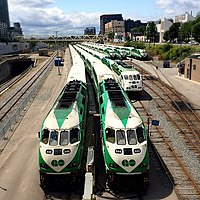
Photo from wikipedia
This paper proposed improved measures for the shortest path fare scheme of urban rail transit. Firstly, this paper simulated Beijing rail transit by using Anylogic simulation technology and shortest path… Click to show full abstract
This paper proposed improved measures for the shortest path fare scheme of urban rail transit. Firstly, this paper simulated Beijing rail transit by using Anylogic simulation technology and shortest path algorithm. Then, in order to find the travel time between any originations and destinations, this research measured the inbound time, waiting time, interval time, section running time, transfer time and outbound time. In addition, this paper used big data analysis technology to obtain the actual travel time distribution between any originations and destinations by processing the basic data of passengers entering and leaving the station. Finally, by comparing the valid path travel time calculated by any originations and destinations with the actual travel time distribution of passengers, the path taken by majority of passengers was pushed back to determine the ticket price based on the mileage of the path taken by the majority of passengers. The results reduced the dependence on government subsidies by rail transit operation and made up for the operation and maintenance costs.
Journal Title: IEEE Access
Year Published: 2020
Link to full text (if available)
Share on Social Media: Sign Up to like & get
recommendations!